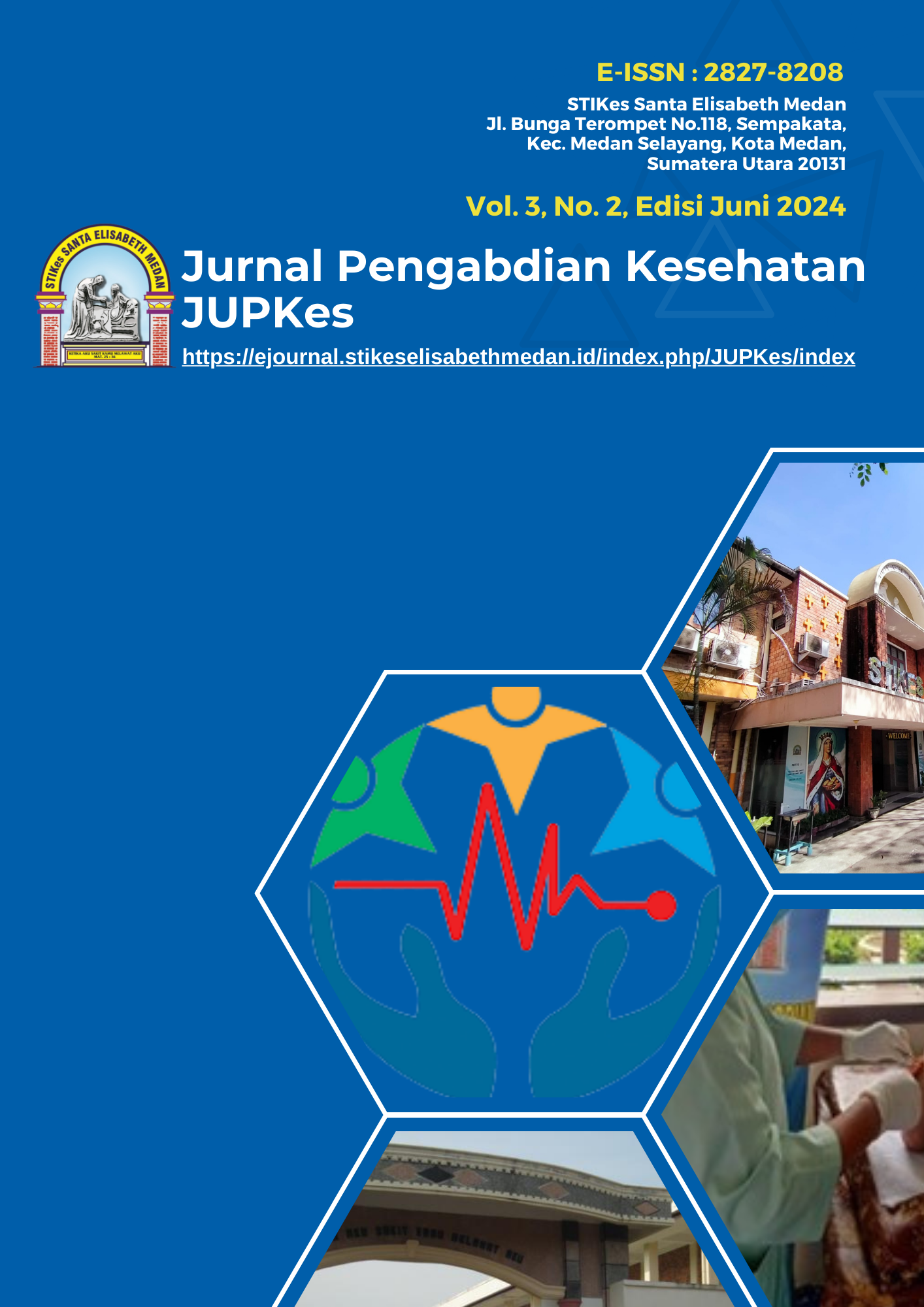MENINGKATKAN SKILL PERAWAT DALAM MELAKSANAKAN PERAWATAN LUKA PADA PASIEN DIABETES MELITUS KOTA KEDIRI
DOI:
https://doi.org/10.52317/JUPKes.v3i2.627Keywords:
Diabetes Melitus, Diabetic Foot Ulcer, DFU, Nursing Training, Stop AmputationAbstract
Diabetes mellitus is a chronic metabolic disease that can cause various serious complications, including diabetic foot ulcers (DFU), which often require intensive treatment and can result in amputation. The global prevalence of DFU reaches 6.3%, with a significant impact on sufferers' quality of life. This community service program aims to improve nurses' skills in caring for diabetic wounds in Kediri City through special training.
The methods used in this program include qualitative and quantitative approaches to collect comprehensive data regarding nurses' knowledge and skills before and after training. This program is implemented in several stages: initial survey to identify training needs, development of comprehensive training materials, implementation of theory and practical sessions, as well as program evaluation through pre- and post-training assessments and participant satisfaction surveys.
The results show that this training was successful in increasing nurses' knowledge and skills significantly. This increase is manifested in knowledge of how to prevent complications and amputations in DFU patients, as well as high participant satisfaction with the training program. However, obstacles such as limited medical equipment and materials as well as management support in health services still need to be overcome to ensure the continuity and effectiveness of the program in the future.
In conclusion, ongoing training is very important to improve the quality of diabetic wound care by nurses, which will ultimately have a positive impact on the outcomes of diabetes patient care.
References
Aalaa, M., Malazy, T., Sanjari, M., Peimani, M., & Mohajeri-Tehrani, M. R. (2012). Nurses’ role in diabetic foot prevention and care; a review. http://www.jdmdonline.com/content/11/1/24
Decroli. (2020). DIAGNOSTIC OF DIABETIC FOOT ULCER.
Doğruel, H., Aydemir, M., & Balci, M. K. (2022). Management of diabetic foot ulcers and the challenging points: An endocrine view. World Journal of Diabetes, 13(1), 27–36. https://doi.org/10.4239/wjd.v13.i1.27
G, A. D., M, B. A. J., & A, B. S. (2024a). Diabetic Foot Ulcers and Their Recurrence. New England Journal of Medicine, 376(24), 2367–2375. https://doi.org/10.1056/NEJMra1615439
G, A. D., M, B. A. J., & A, B. S. (2024b). Diabetic Foot Ulcers and Their Recurrence. New England Journal of Medicine, 376(24), 2367–2375. https://doi.org/10.1056/NEJMra1615439
Hasdi, H., Syahrul, S., Yusuf, S., Kesehatan, D., Parepare, K., & Keperawatan, F. (2022). NURSES’ KNOWLEDGE ABOUT DIABETES FOOT ULCER PREVENTION AND TREATMENT: AN INTEGRATIVE REVIEW. In Indonesian Contemporary Nursing Journal (Vol. 7, Issue 1).
Lim, J. Z. M., Ng, N. S. L., & Thomas, C. (2017). Prevention and treatment of diabetic foot ulcers. In Journal of the Royal Society of Medicine (Vol. 110, Issue 3, pp. 104–109). SAGE Publications Ltd. https://doi.org/10.1177/0141076816688346
McDermott, K., Fang, M., Boulton, A. J. M., Selvin, E., & Hicks, C. W. (2023). Etiology, Epidemiology, and Disparities in the Burden of Diabetic Foot Ulcers. In Diabetes Care (Vol. 46, Issue 1, pp. 209–211). American Diabetes Association Inc. https://doi.org/10.2337/dci22-0043
Meloni, M., Izzo, V., Giurato, L., Lázaro-Martínez, J. L., & Uccioli, L. (2020). Prevalence, clinical aspects and outcomes in a large cohort of persons with diabetic foot disease: Comparison between neuropathic and ischemic ulcers. Journal of Clinical Medicine, 9(6), 1–11. https://doi.org/10.3390/jcm9061780
Pedras, S., Carvalho, R., & Pereira, M. G. (2016). Quality of Life in Portuguese Patients with Diabetic Foot Ulcer Before and After an Amputation Surgery. International Journal of Behavioral Medicine, 23(6), 714–721. https://doi.org/10.1007/s12529-016-9567-6
Saluja, S., Anderson, S. G., Hambleton, I., Shoo, H., Livingston, M., Jude, E. B., Lunt, M., Dunn, G., & Heald, A. H. (2020). Foot ulceration and its association with mortality in diabetes mellitus: a meta-analysis. Diabetic Medicine, 37(2), 211–218. https://doi.org/https://doi.org/10.1111/dme.14151
WHO. (2024). Diabetes. https://www.who.int/health-topics/diabetes#tab=tab_2
Zhang, P., Lu, J., Jing, Y., Tang, S., Zhu, D., & Bi, Y. (2017). Global epidemiology of diabetic foot ulceration: a systematic review and meta-analysis†. In Annals of Medicine (Vol. 49, Issue 2, pp. 106–116). Taylor and Francis Ltd. https://doi.org/10.1080/07853890.2016.1231932

Downloads
Published
Issue
Section
License
Copyright (c) 2024 Devangga Darma Karingga, Moh Alimansur (Author)

This work is licensed under a Creative Commons Attribution 4.0 International License.


